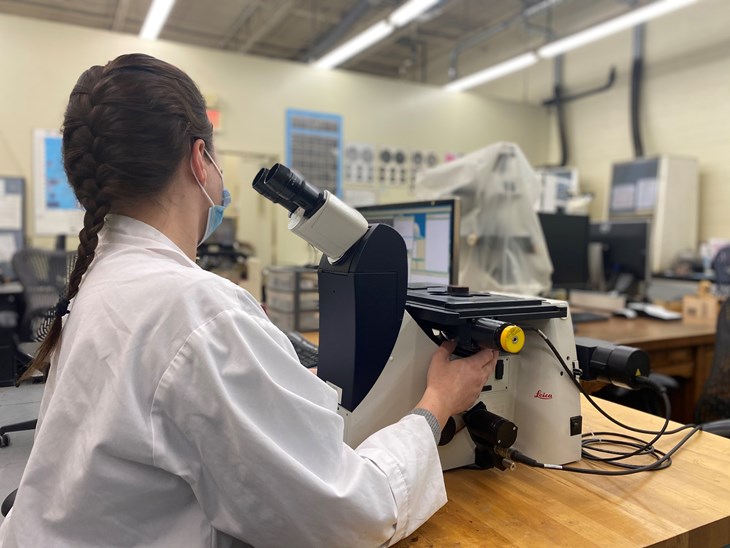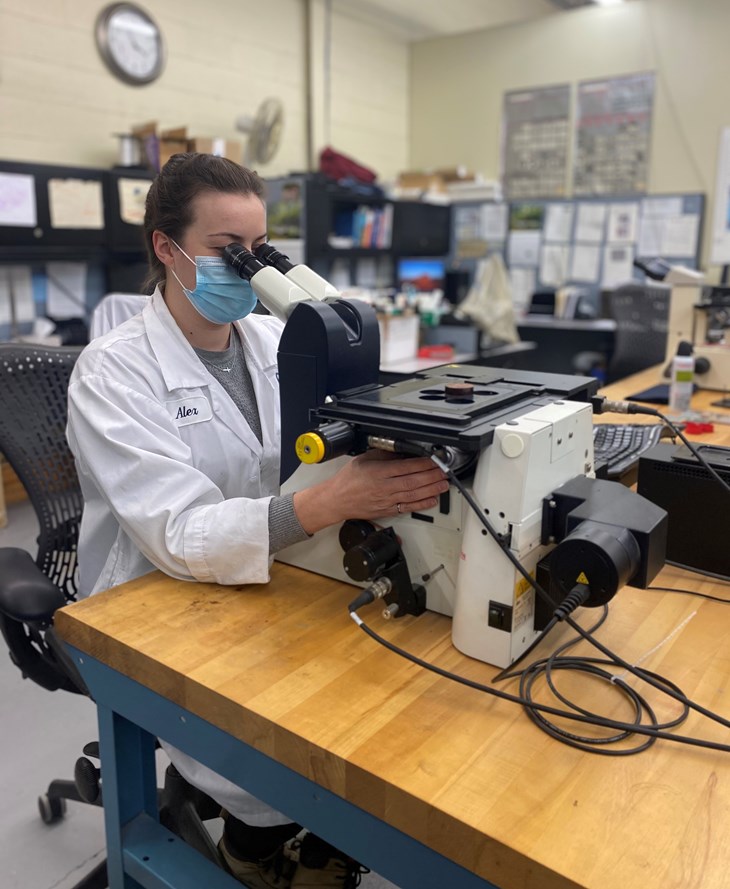In part one of this interview, Stainless Steel World Americas had the opportunity to speak with Kobylecky about how she got her start in the industry, what her daily routine looks like, and what she has discovered throughout her career so far working with corrosion resistant alloys (CRAs).
By Brittani Schroeder.
Alex Kobylecky’s journey into the world of corrosion resistant materials (CRAs) began in her undergraduate engineering degree at McMaster University, located in Hamilton, Ontario, Canada. For two summers during her undergrad, she worked as a Research Assistant at the McMaster Automotive Resource Centre in the Centre for Automotive Materials and Corrosion (CAMC). “My projects included investigating the corrosion performance and behavior of welded alloys, and evaluating the performance of lightweight coated automotive alloys after exposure to a salt fog solution,” says Kobylecky. “These were my first experiences in a laboratory setting outside of a classroom. This is where I learned lab-specific protocols and procedures, took safety training, and learned how to operate different types of equipment for the testing I was responsible for – such as a salt fog chamber, sample prep equipment, optical microscopes and a scanning electron microscope. My summers at CAMC were integral to my development as a metallurgist.”
The summer between her fourth and fifth years at McMaster, Kobylecky worked as a Mechanical Testing Technician at Cambridge Materials Testing Limited (CMTL). CMTL is an independent materials testing laboratory that is NADCAP accredited and ISO certified, according to the Standards Council of Canada. During her time there, Kobylecky operated the machines for tensile testing, charpy toughness testing, and hardness testing of metals, fabrics, plastics, and any other material where strength and other properties had to be determined. “Learning how test samples were made, tested, and how to interpret results gave me a better understanding of the purpose and necessity for materials testing in all engineering fields. This experience was very useful during my final year at McMaster and in my first job after graduation,” she admits.
After completing her undergraduate degree in 2016, Kobylecky worked as a Metallurgist at Steel Image Inc., which is a company that specializes in failure analysis. Kobylecky learned a lot of her practical metallurgy skills and developed her sample preparation skills in the lab. “I was responsible for keeping inventory of incoming projects, photographing, sectioning, mounting, and manually polishing and etching most of the samples for the first six months of my employment. I worked alongside other metallurgists and engineers, observing how they conduct failure analysis investigations and how to connect what I saw during the investigation with background information, service history, material composition, and design of the part,” explains Kobylecky. “I was exposed to a variety of parts from different industries, including oil and gas, mining, automotive, and energy industries, such as a slurry mixing shaft used in a mine, a failed wind turbine, corroded boiler tubes, and much more. It was a fast-paced work environment, which required critical thinking and efficient teamwork to provide results within a short time frame. The skills and work ethic I developed in my experiences during school and at Steel Image Inc., have all contributed so much to the work I do now.”

The role of a metallurgist
After working with Steel Image Inc. for a few years, Kobylecky was offered a full-time position at CMTL, this time in the metallurgy department. “A friend of mine had recommended me for a metallurgist position and the company decided to reach out. Even though I was already employed, I took the risk of starting a new job and here I am, one of three metallurgists at the company,” Kobylecky states. Currently, Kobylecky is also waiting to hear about the status of her Professional Engineering license.
In her role, Kobylecky conducts standardized testing, metallurgical examinations, and failure analysis investigations. “The standardized testing requires a thorough understanding of material requirements and testing specifications, as well as a thorough understanding of how to operate the software we use to conduct some of the tests. Most of the projects require that specific testing parameters be followed, while others are more open-ended with customers needing to find out more information about their products, such as microstructure identification, confirmation of correct heat treatment, surface plating thickness, and examination for presence of defects,” she explains. “We reverse engineer parts, metallurgically compare parts against other lots for defects, and identify microstructures.”
For the standardized testing, customers reference a specification to follow, so it is Kobylecky’s job to find that specification and ensure the sample is prepared and tested, according to the outlined parameters and procedures. Other times, customers want to verify their material, heat treatment, examine parts for defects, reverse-engineer parts, or find out if certain features are detrimental to the part and could possibly result in failure. “It is my job to understand what the customers are looking for and provide them with as much useful information as possible.”
Kobylecky mostly performs destructive testing, which requires sectioning samples, preparing them by grinding and polishing them, and then examining them under a microscope. At times, customers want to verify microstructures non-destructively, so Kobylecky also performs in-situ metallography. She continues, “This requires grinding and polishing the surface of a finished part without removing too much material or cutting into it. The surface is prepared and acetate tape is used to replicate the etched microstructure, which is then transferred to another surface for examination under a microscope.”
A typical working day for Kobylecky involves completing any ongoing projects she may have, starting new projects, or assisting other metallurgists and engineers with their projects. “At times we have high priority projects submitted that need to be completed within one to three days, which require efficient timing, evaluation, and report writing,” Kobylecky states. “I prepare my samples, conduct the evaluations, and write a report outlining the findings which then get sent to our customers. I have started corresponding directly with certain customers about high volume projects or failure analyses as it is easier to find out exactly what they are looking for.” Daily work varies for Kobylecky and can include hardness testing, weld evaluations, microscopic examinations, or failure analysis investigations, all meeting various deadlines.

The joys of the job
The balance between a daily routine and a variety of projects is what Kobylecky likes most about her career. “There is a set way to prepare samples, no matter the project: photograph, cut, mount polish, etch, and examine. But sometimes a few changes need to be made to the preparation process in order to evaluate the sample. This is dependent on the test required, part size, and material type. There is always something new coming in and a new test I have to learn to perform that I may never have done before,” says Kobylecky. “Deadlines usually vary between 3 to 10 business days, with failure analysis investigations taking longer. Sometimes we have projects that need to be completed by the next day, so it is a balancing act to get the rush job done without taking away too much time from other projects. It keeps me on my toes and there is always something to do.”
Like every job, Kobylecky experiences challenges in her work as well. “The challenges come from conducting the failure analysis investigations or having to interpret microstructures for materials that I do not see frequently. Whenever I am working on a failure analysis, I am constantly thinking about the loading, the progression of failure, if the part integrity has been altered in some way, and how that all ties into the failure itself. I need to connect what I see during the metallurgical examination to the information provided about service life, manufacturing, intended purpose, and use; find any discrepancies and come to an evidence-based conclusion on how and why something failed. It is a matter of combining what I know, researching more about what I am not familiar with, and reaching out to colleagues who might have seen similar failure mechanisms before. It is a lot of work,” Kobylecky explains.

Working with specialty alloys
As a Metallurgist, Kobylecky has worked on many types of materials, including various types of stainless steels and duplex stainless steels, Inconel, titanium, zirconium, aluminum and carbon steels. “The most common materials I see are 300 and 400 series stainless steel for welding components, Inconel alloys for welded tube to tubesheets for heat exchangers and superheaters, and 2205 duplex for welding applications and parts like flanges and pipes for filtration and heating systems. Most of the applications use these alloys for corrosion resistance or high temperature service, or a combination of both, depending on the industry,” Kobylecky says.
As Kobylecky would say, one challenging aspect of working with corrosion resistant alloys (CRAs) and exotic alloys is the ability to find a suitable etchant. An etchant is a combination of specific acids and solutions. When that etchant is applied to a certain material, it will reveal the microstructure. Etching can be done electrolytically or more commonly through immersion or swabbing. “The more exotic the alloy, the more we have to research to see which chemicals can be combined to reveal the microstructure of certain phases,” explains Kobylecky. “There are common etchants we use everyday, but on occasion we have zirconium alloys or 3D-printed titanium alloys sent in for micro examination. These materials require a little more research to make sure the etchant or multiple etchants we use will reveal the true microstructure. Without the correct etchant, we would not be able to analyze our samples or identify the structure.”
The most urgent problem Kobylecky faces in specialty alloys is unexpected and unplanned corrosion failures. “When these materials are chosen specifically for a design because of their corrosion resistant properties and somehow, they still fail, it comes down to determining if and when the parts could have become exposed to detrimental contaminants, as well as how long the exposure lasted before the part started to fail,” she relays.
Aside from failures, the welding of exotic alloys can also be tricky. Kobylecky has performed macro examinations of welded Inconel tube to tubesheet blocks where the customer had to resubmit multiple times due to unacceptable defects in the welds. She continues, “Although I was not privy to the details of the welding and parameters, some samples met the requirements, while others were consistently failing. Eventually, the welding parameters of the process were tweaked and the welds met the requirements.”
Read part two of this interview in the June 2021 issue of Stainless Steel World Americas.




